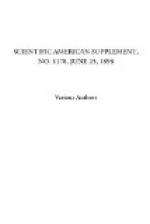All this I note, because this is the first occasion that United States troops have been in action since the civil war, and because I have more than once heard European officers question the possibility of making an army out of elements different from those to which they were accustomed. I have heard Germans insist that unless the officer appears in uniform he cannot command the respect of his men. On this ship it would be frequently difficult to tell officers from men when the tunic is laid aside and shoulder straps are not seen. There are numberless points of resemblance between Tommy Atkins and the Yankee private; and the Sandhurst man has no difficulty in understanding the West Pointer. But to do this we must go a little beneath the surface and see things, not on the parade ground, but in actual war. For dress occasions the American uniform is far and away the ugliest and most useless of all the uniforms I know. The helmets and cocked hats are of the pattern affected by theatrical managers, the decorations tawdry, the swords absurd, the whole appearance indicative of a taste unmilitary and inartistic. The parade uniform has been designed by a lot of unsoldierly politicians and tailors about Washington. Their notion of military glory is confused with memories of St. Patrick’s Day processions and Masonic installations. They have made the patient United States army a victim of their vulgar designs, and to-day at every European army maneuver one can pick out the American military attache by merely pointing to the most unsoldierly uniform on the field. On the battlefield, however, there are no political tailors, and the Washington dress regulations are ruthlessly disregarded.
* * * * *
STEERING GEAR OF NORTH GERMAN LLOYD STEAMERS “COBLENTZ,” “MAINZ,” AND “TRIER.”




